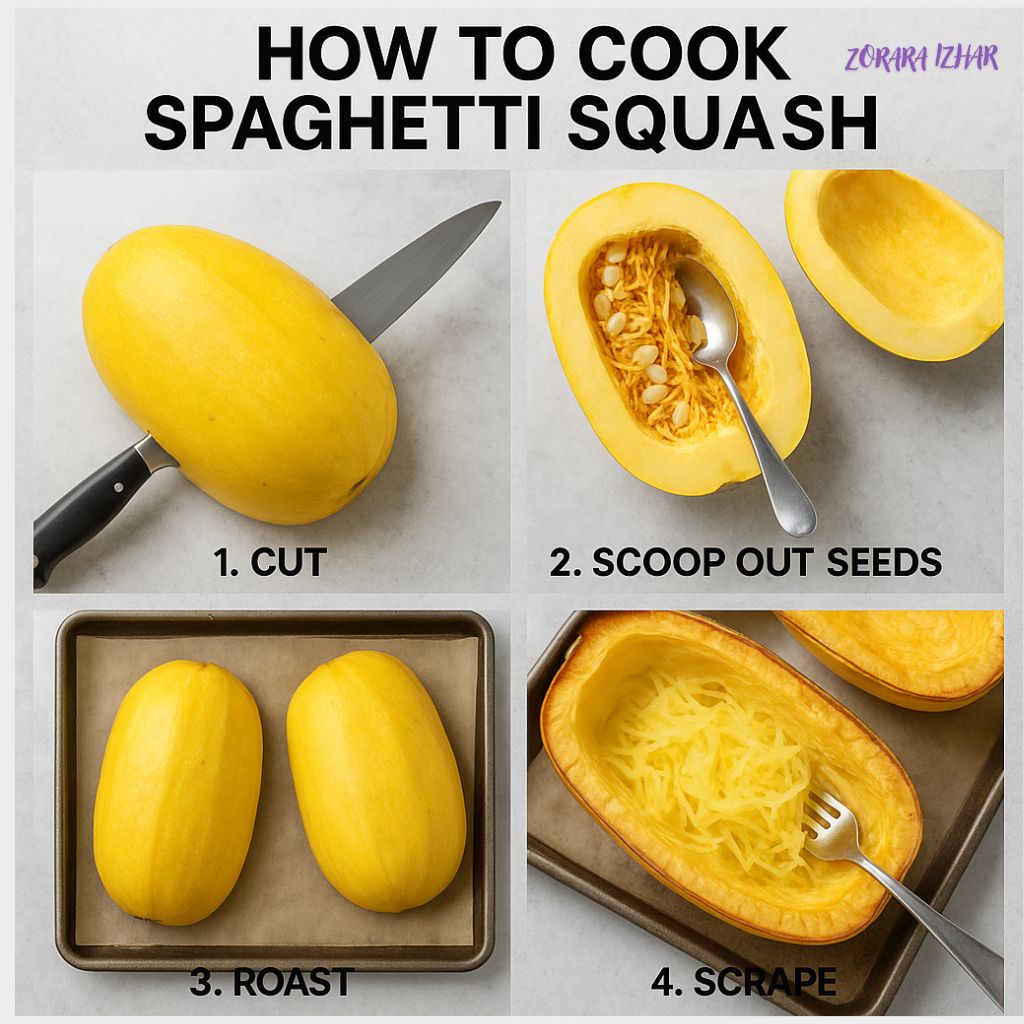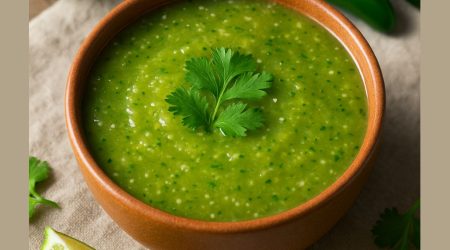23
Jun
How to Cook Spaghetti Squash
Spaghetti squash, known for its stringy, noodle-like texture after cooking, has become a star in healthy kitchens. This yellow winter squash is not only low in calories and carbs but also rich in fiber, vitamin C, and antioxidants.
When cooked, the flesh transforms into strands resembling pasta perfect for gluten-free meals or low-carb diets. Whether you’re a busy home cook or a culinary experimenter, spaghetti squash offers a wide range of preparation methods to match your style and schedule.
Boiling is a straightforward way to cook the whole squash, but it does result in a slightly softer texture.
1. Bring a large pot of water to a boil.
2. Cut squash in half or into rings.
3. Boil for 15–20 minutes until tender.
4. Drain, cool slightly, and shred with a fork.
Avoid overboiling, as it can turn the strands mushy.
Preparing Spaghetti Squash for Cooking
Before diving into the different cooking methods, proper preparation is key. Here’s how to start: Selecting the Right Squash Choose a spaghetti squash that feels heavy for its size, with a hard, unblemished rind. Avoid soft spots or cracks. Washing and Cutting Tips Rinse the squash under cold water to remove any dirt. Cutting a spaghetti squash can be tricky—use a sharp chef’s knife and cut lengthwise for longer strands or widthwise for shorter strands. Removing Seeds Safely Scoop out the seeds and stringy pulp using a spoon. You can save the seeds for roasting—just like pumpkin seeds!Roasting Spaghetti Squash
Roasting is perhaps the most popular method—it brings out a naturally sweet, caramelized flavor. 1. Preheat your oven to 400°F (200°C). 2. Cut the squash in half, scoop out the seeds, and brush the inside with olive oil. 3. Season with salt, pepper, or herbs like thyme and rosemary. 4. Place cut-side down on a baking sheet. 5. Roast for 35–45 minutes, until tender. 6. Scrape with a fork to create the signature spaghetti-like strands. Pro Tip: For added flavor, sprinkle garlic powder or parmesan cheese before roasting.Microwaving Spaghetti Squash
Need dinner in a hurry? The microwave has you covered. 1. Pierce the squash several times with a fork. 2. Microwave whole on high for 5–6 minutes. 3. Let it cool slightly, then cut and remove seeds. 4. Microwave each half face-down in a dish with a bit of water for 6–8 more minutes. This method is ideal for quick lunches or weeknight meals. Boiling Spaghetti Squash
Boiling Spaghetti Squash
Boiling is a straightforward way to cook the whole squash, but it does result in a slightly softer texture.
1. Bring a large pot of water to a boil.
2. Cut squash in half or into rings.
3. Boil for 15–20 minutes until tender.
4. Drain, cool slightly, and shred with a fork.
Avoid overboiling, as it can turn the strands mushy.
Steaming Spaghetti Squash
Steaming preserves the nutrients and delivers a clean, natural taste. 1. Cut the squash in half and remove seeds. 2. Place in a steam basket over boiling water. 3. Cover and steam for 20–30 minutes. 4. Check for doneness with a fork. It’s a gentle method perfect for young children or those with sensitive digestion.Cooking Spaghetti Squash in an Instant Pot
Instant Pot fans rejoice—spaghetti squash can be done in under 10 minutes! 1. Place a trivet in the pot and add one cup of water. 2. Put in halved squash, cut-side up. 3. Seal and set to pressure cook for 7 minutes. 4. Quick-release pressure and let cool slightly before shredding. Great for busy weeknights!Slow Cooker Spaghetti Squash
The crockpot method allows you to set it and forget it. 1. Place the whole squash in a slow cooker with 1–2 cups of water. 2. Cover and cook on low for 5–6 hours or on high for 3–4 hours. 3. Slice, remove seeds, and fluff into strands. The slow cook gently enhances flavor and texture.Air Fryer Method
For crispy edges and a quicker cook, the air fryer is fantastic. 1. Cut squash into halves or quarters. 2. Brush with oil and season. 3. Air fry at 375°F (190°C) for 20–25 minutes. 4. Check for fork-tender consistency. It’s a healthier alternative to frying and keeps cleanup minimal.Grilling Spaghetti Squash
Add smoky depth by tossing it on the grill. 1. Slice squash into rounds or thick slices. 2. Brush with olive oil and season. 3. Grill over medium heat for 5–7 minutes per side. 4. Scrape into strands after cooling slightly. Perfect for outdoor BBQs and smoky dishes.Stuffed Spaghetti Squash Bakes
Once your squash is cooked, you can turn it into a complete meal by stuffing it with your favorite fillings. Here’s how to do it: 1. Roast or microwave the squash halves. 2. Scrape the strands slightly to make space. 3. Mix the strands with your desired fillings: ground turkey, marinara sauce, spinach, mushrooms, cheese, beans, etc. 4. Spoon the mixture back into the squash shell. 5. Top with cheese or breadcrumbs and bake at 375°F (190°C) for 10–15 minutes until golden and bubbly.Popular Stuffing Ideas:
- Taco-style with black beans, salsa, and cheddar
- Mediterranean with olives, feta, and cherry tomatoes
- Classic Italian with marinara, mozzarella, and basil
Using Spaghetti Squash as a Pasta Substitute
One of the most beloved uses of spaghetti squash is as a substitute for traditional pasta. Its mild flavor and stringy texture make it perfect for pairing with various sauces.Perfect Sauce Pairings:
- Marinara or Bolognese sauce
- Alfredo or creamy mushroom sauce
- Pesto with pine nuts and cherry tomatoes
- Thai peanut or teriyaki sauce for an Asian twist
Creative Ways to Serve Cooked Spaghetti Squash
Don’t just stop at pasta replacements—there are endless ways to get creative with this versatile veggie: Spaghetti Squash Bowls Use the squash shell as a natural bowl and fill it with stir-fried veggies, scrambled eggs, or grilled shrimp. Asian-Inspired Stir-Fry Toss cooked strands with soy sauce, sesame oil, garlic, and mixed vegetables for a light stir-fry. Spaghetti Squash Breakfast Hash Mix with sautéed peppers, onions, and eggs for a nutritious breakfast alternative. Cheesy Squash Fritters Combine strands with eggs, cheese, and herbs, form into patties, and pan-fry until golden. These ideas make meal planning fun while boosting your veggie intake.Storage and Reheating Tips
Cooked spaghetti squash stores well, making it perfect for meal prep. Refrigerating Place cooked strands in an airtight container. Store for up to 5 days in the fridge. Freezing Freeze cooled strands in a freezer-safe bag. Remove as much air as possible to avoid freezer burn. Use within 2–3 months. Reheating Microwave in short bursts with a splash of water or reheat in a skillet over medium heat. Avoid overcooking to preserve texture.Common Mistakes to Avoid
Even though spaghetti squash is easy to cook, beginners often make these errors: Overcooking: Makes the strands soggy and mushy. Under-seasoning: It has a mild flavor that benefits from herbs, spices, or sauces. Cutting unsafely: Always stabilize your cutting board and use a large knife. Ignoring moisture content: Let squash cool before scraping to avoid watery results. Learning from these pitfalls ensures better results every time.Frequently Asked Questions
1. Can I eat the skin of spaghetti squash? No, the skin is too tough to eat, even after cooking. Always scoop out the flesh and discard the skin. 2. How do I know when spaghetti squash is fully cooked? It's done when a fork easily pierces the flesh and the strands separate with minimal effort. 3. Is spaghetti squash low in carbs? Yes, it’s significantly lower in carbs than pasta—just about 10g per cup, making it ideal for low-carb diets. 4. Can I cook spaghetti squash whole? Yes! Pierce it a few times and microwave or bake it whole. Cut it open afterward to remove seeds and scrape strands. 5. What does spaghetti squash taste like? It has a mild, slightly sweet flavor, similar to other squashes. It absorbs seasonings and sauces well. 6. Is spaghetti squash suitable for babies or toddlers? Yes, once cooked and mashed or chopped finely, it’s a healthy, nutritious option for young children.Conclusion
So, what are different ways to cook spaghetti squash? As you’ve seen, the possibilities are vast from roasting and microwaving to slow cooking and stuffing. This humble squash transforms into spaghetti-like strands that can be used in dozens of creative, healthy meals. Whether you're trying to cut carbs, add more veggies, or simply explore new recipes, spaghetti squash delivers versatility and flavor without compromise.Share this post
RELATED
Posts
How to make the green Mexican sauce?
If you’ve ever tasted tacos, enchiladas, or grilled meats topped with a tangy, spicy green sauce, chances are you’ve encountered salsa Verde, the beloved green Mexican sauce. This vibrant condiment is a staple in Mexican cuisine, made with fresh ingredients...




